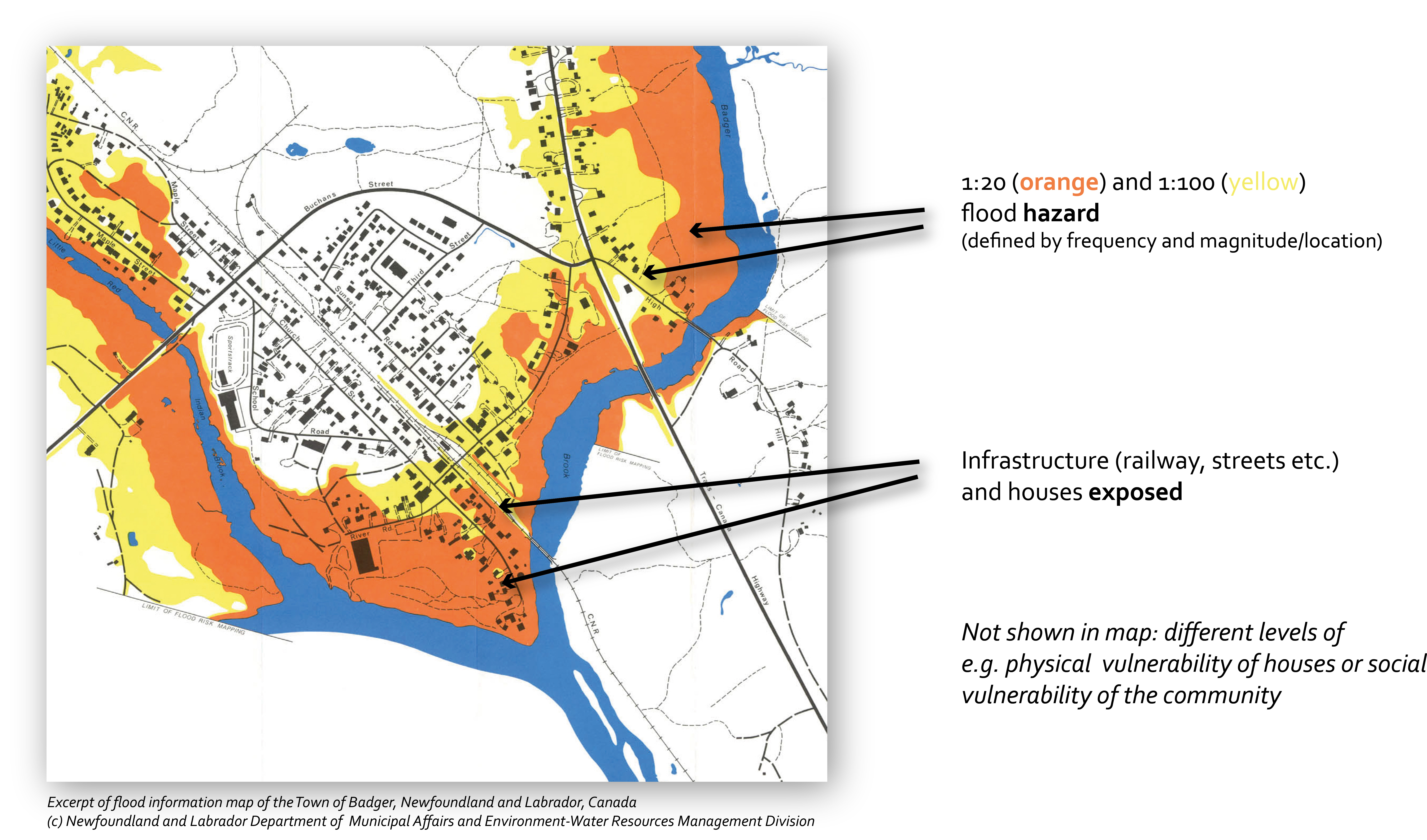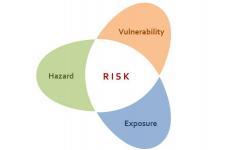When a hazard event (such as a drought, flood, cyclone, earthquake or tsunami) occurs, triggering a loss of life and damage to infrastructure, it highlights the reality that society and its assets are vulnerable to such events. When discussing disaster risk management, a disaster can highlight the following in a community:
- The geographical area where the community is settled is exposed to such a hazard.
- The society (including individuals) and its infrastructure, assets and other processes - as well as services which may have experienced damage or destruction - are vulnerable.
Disaster Risk
According to the terminology of UNDRR, disaster risk is defined as “the potential loss of life, injury, or destroyed or damaged assets which could occur to a system, society or a community in a specific period of time, determined probabilistically as a function of hazard, exposure, vulnerability and capacity. In the technical sense, it is defined through the combination of three terms: hazard, exposure and vulnerability.
For example, when a settlement is established on the shores of a river, hydrologists can identify and characterise flood hazard by carrying out a hydraulic analysis. According to the UNDRR definition, a hazard is characterised by its "location, intensity or magnitude, frequency and probability”. In some countries, such hazard areas outline the geographic extent of floods that have a 100 year period of possible return. Any people, assets, infrastructure, and ecosystems located inside the area are all exposed to potential damage from floods. The degree of potential damage is then characterised by the area's vulnerability. For example, this can be defined by the physical structure of a building, as well as by the social and economic characteristics of a system. Additionally, hazard vulnerability can be characterised by the capacities of a society to cope with a hazard.

Definitions and Terminology
Hazard is defined as “a process, phenomenon or human activity that may cause loss of life, injury or other health impacts, property damage, social and economic disruption or environmental degradation”. Hazards may be single, sequential or combined in their origin and effects. Each hazard is characterized by its "location, intensity or magnitude, frequency, and probability".
Exposure is defined as “the situation of people, infrastructure, housing, production capacities and other tangible human assets located in hazard-prone areas”. As stated in the UNDRR glossary, “measures of exposure can include the number of people or types of assets in an area. These can be combined with the specific vulnerability and capacity of the exposed elements to any particular hazard to estimate the quantitative risks associated with that hazard in the area of interest”.
Vulnerability is defined as “the conditions determined by physical, social, economic and environmental factors or processes which increase the susceptibility of an individual, a community, assets or systems to the impacts of hazards”. Vulnerability is multi-dimensional in its nature, and next to the four dimensions above, some authors also include cultural and institutional factors. Examples include, but are not limited to: poor design and construction of buildings, inadequate protection of assets, lack of public information and awareness, high levels of poverty and education, limited official recognition of risks and preparedness measures, disregard for wise environmental management or weak institutions, and governance (e.g. including corruption etc.).
Disaster Risk Reduction is aimed at preventing new and reducing existing disaster risk and managing residual risk, all of which contribute to strengthening resilience and therefore to the achievement of sustainable development". The UNDRR definition further annotates that “disaster risk reduction is the policy objective of disaster risk management, and its goals and objectives are defined in disaster risk reduction strategies and plans". Disaster Risk Reduction strategies and policies define goals and objectives across different timescales, with concrete targets, indicators and time frames.
Disaster Risk Management is the application of disaster risk reduction policies and strategies, to prevent new disaster risks, reduce existing disaster risks, and manage residual risks, contributing to the strengthening of resilience and reduction of losses. Disaster risk management actions can be categorized into; prospective disaster risk management, corrective disaster risk management and compensatory disaster risk management (also referred to as residual risk management).
Information management in Disaster Risk Reduction
In recent years, researchers and experts have been developing methods to conduct the assessment of hazards, vulnerability, and coping capacities; as well as techniques to combine such assessments in order to present them in risk map format. Such maps are essential in developing strategies to reduce the level of existing risks, and as a way to avoid a generation of new risks due to underlying social and economic risk drivers. Read more about it.
The UN and Disaster Risk Reduction
Since the beginning of the 1990s, the United Nations has been promoting efforts to change the paradigm of disasters, advocating for the incorporation of disaster risk reduction efforts worldwide as a way to reduce the effects of natural hazards on vulnerable communities. In 2015, UNDRR facilitated the negotiations amongst Member States, experts and collaborating organizations; which led to the adoption of the Sendai Framework for Disaster Risk Reduction 2015-2030. Between 2015 and 2030, Member States around the world will conduct a variety of efforts within the context of the four Priority Areas contained in the Sendai Framework, as a way to reduce risks with the goal of minimizing losses due to the manifestation of hazards of natural origin. The four Priority Areas are:
Priority 1: Understanding disaster risk
Priority 2: Strengthening disaster risk governance to manage disaster risk
Priority 3: Investing in disaster risk reduction for resilience
Priority 4: Enhancing disaster preparedness for effective response and to “Build Back Better” in recovery, rehabilitation and reconstruction

